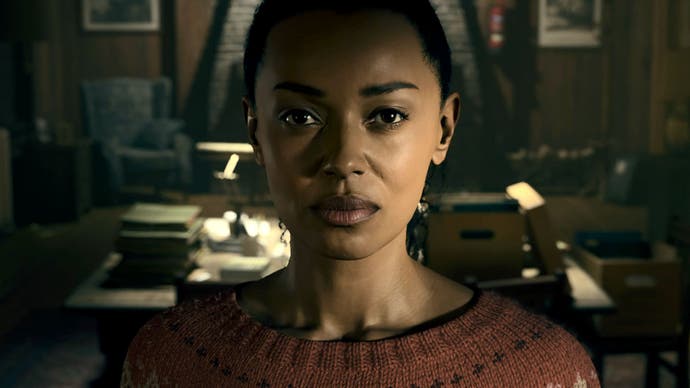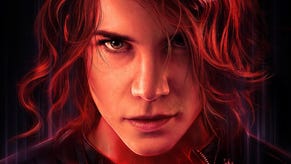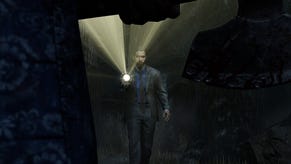Alan Wake 2: a deep dive into Remedy's high-end ray tracing
Along with optimised RT settings.
Alan Wake 2 is sublime - a masterclass in the visual arts - and while it still manages to look fine on consoles from Xbox Series S upwards, it's with high-end PC that you get to see Remedy's masterpiece at its absolute best thanks to hardware-accelerated ray tracing, path tracing and DLSS 3.5 ray reconstruction. The question is: do you need best-of-the-best hardware like RTX 4080 or RTX 4090 to benefit from the experience? Well, it's a demanding experience to be sure, but we were happy with the results we gleaned from RTX 3080 and its nearest 40-series equivalent, RTX 4070, both running at 1440p output resolution. And of course, those settings can and will provide similar scalability on other RT-capable GPUs, though your mileage may vary.
There's scalability then, but let's kick off by taking a look at the individual RT features and what they actually do. Ray-traced direct lighting essentially adds RT shadows to all light sources. Alan Wake 2's standard shadow maps can be temporally unstable, and also switch from different quality shadows depending on distance, resulting in some obvious 'popping' as you move through the cascade.
Rasterised shadows also have a uniform sharpness to them, whereas in real life, shadows are sharper the closer to the casting light source they are, tapering off into the distance. This is linked to another problem: not every object casts shadows. RT shadows in Alan Wake 2 solve each and every one of these issues, while common problems in other games with this effect are also side-stepped. RT shadows often do not animate, for example. This particularly jarring on elements like vegetation, but it's not an issue in this game.
Next up, let's discuss path-traced indirect lighting, which accounts for the dramatic increase in reflection quality via RT in Alan Wake 2. At the surface level, this has all the advantages of other RT reflection implementations in other games.
Without RT, reflections are calculated using information within screen-space. This looks fine, except that when information is not in screen-space, there's nothing to add into a reflection which remains visible, creating jarring visual discontinuities. This means that panning up/down with, say, a lake in view sees reflection detail vanish as the content being reflected moves out of screen-space.
However, in Alan Wake 2, you can see that light sources behind a player (like sunlight streaming through a window, for example) can also cause reflections within the viewport to present in a completely different way to the SSR alternative. The light shows up in the reflective sheen of a varnished doorway, for example, while the window itself may be reflected in the glass of a framed photograph. The presentation of the reflection can also be influenced by variations in the glass itself.
Path tracing in Alan Wake 2 also covers diffuse lighting as well, which essentially means that light still bounces across duller surfaces. Short of some of the dramatic head-to-head comparisons in the video above, the effect can be quite subtle - and this is because it seems that Remedy is integrating path-tracing with its existing global illumination solution. It's excellent for a non-RT foundation, but as you'll notice in the video, there are a number of 'errors' that manifest as a consequence, and which path tracing is not 'fixing'.
The upside to this is that people not using path tracing get good enough diffuse global illumination in the game, and technically, the path tracing might need less denoising perhaps, but the downside of it is that the path tracing inherits visual errors from the other GI solution running in tandem with it. That is why turning it on and off in some scenes does not change the look of the game that much, in stark contrast to the way path tracing is transformative in Cyberpunk 2077.
In the end, I am a little conflicted on how the lighting is set up in Alan Wake 2. I love what the path tracing does for specular lighting, but the way it affects diffuse lighting mixing with the other GI system means that it is more error prone and less precise. Still, the game does look much better on the micro scale due to the path tracing since the other GI system really cannot work there at all in a meaningful way.
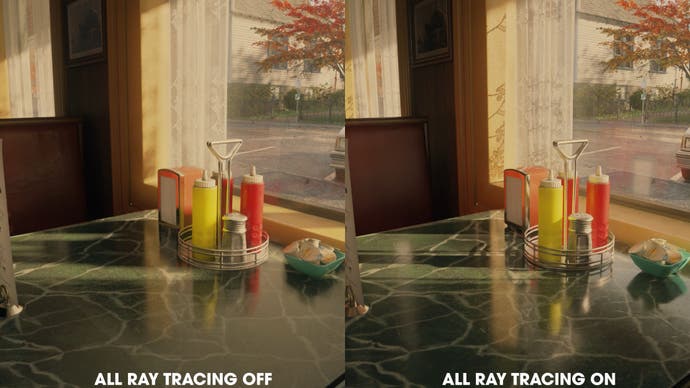
| RT Optimised Settings | Target: RTX 3080 1440p | Target: RTX 4070 1440p |
|---|---|---|
| Direct Lighting | On | On |
| Ray Reconstruction | On | On |
| Indirect Lighting | Off | Low |
| Transparency Lighting | Off | Low |
| Frame Generation | N/A | On |
Looking at optimised settings, I wanted to choose the RTX 3080 as an example GPU as it is extremely common and it is still very powerful. At the same settings as the PS5 for example, we can see it achieving nearly twice the performance, but adding the path tracing options with DLSS ray reconstruction sees performance collapse to circa 30fps. The good news is that there's scalability in the RT options, and it's possible for us to nigh on double performance while retaining the lion's share of the path-traced glory. This is quite an involved topic, so I'd recommend watching the video for an in-depth look at the performance cost of each of the primary RT features and how we settled upon these optimised settings.
I also conducted tests on the RTX 4070 in parallel as essentially it offers 3080-class performance, but found that on PS5 settings, it's actually 14 percent slower than the 3080. However, if you compare it with the full path tracing suite enabled with DLSS ray reconstruction, the tables flip. The RTX 4070 is now outperforming the 3080 by 26 percent. And that's before we even factor in DLSS 3 frame generation, which looks and runs very well on this title.
Finally, I wanted to discuss DLSS ray reconstruction, which I do recommend for Nvidia owners, even though many of the issues I saw with Cyberpunk 2077 remain in place here. Reflections in motion are much better reconstructed than the standard denoiser, with the standard denoiser smearing by comparison. It's the same with rapid lighting changes, which look much more snappy and natural with ray reconstruction - it is noticeably more responsive.
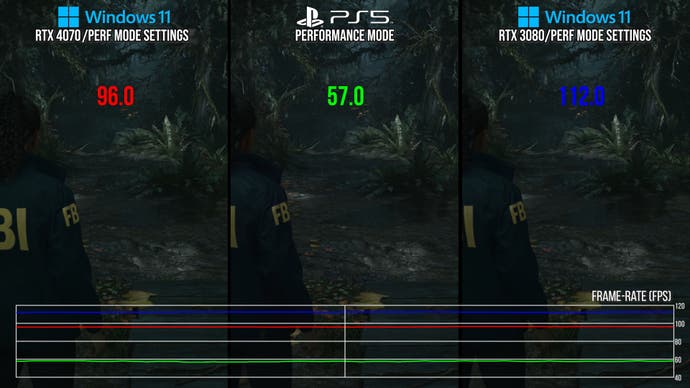
| Non-RT Settings | PS5 Performance Mode | PC Medium Preset | PS5 Quality Mode |
|---|---|---|---|
| Post-Processing | Low | High | Low |
| Texture Resolution | Medium+ | High | Medium+ |
| Texture Filtering | Low | Medium | Medium |
| Volumetric Lighting | Low | Medium | Medium |
| Volumetric Spotlight Quality | Low | Medium | Medium |
| Global Illumination Quality | Medium | High | High |
| Shadow Resolution | Low | Medium | Medium |
| Shadow Filtering | Medium | High | High |
| Shadow Detail | Medium | Medium | Medium |
| SSAO | On | On | On |
| Global Reflections | Low | Low | Low |
| Screen-Space Reflections | Low | Low | Low |
| Fog Quality | Medium | High | High |
| Terrain Quality | Medium | High | High |
| Far Object Detail (LOD) | Medium | High | High |
| Scattered Object Density | Medium | Ultra | Ultra |
I would also say that the game does look less artificially sharpened with ray reconstruction compared to Cyberpunk, but the issue is still there. A great place to show it is on character faces, where the sharpening aspect for normal maps with ray reconstruction kills the game's subsurface scattering at times.
Another aspect I want to see improved in ray reconstruction is its tendency to over-sharpen. The lower the internal resolution is, the more obviously it presents. Lower DLSS presets make it more obvious and give the game a posterized look in certain lighting conditions. Ray reconstruction is just as transformative as DLSS 2 was when it appeared, but in a similar vein, it's clearly a first-gen tech in need of further iteration.
Even so, I'm deeply impressed by Alan Wake 2's RT implementation and I hope the 30-minute video I put together helps to explain how the game can transform on both the micro and macro levels, while at the same time demonstrating that absolute top-tier hardware isn't a necessity - but it obviously helps if you're looking for that pristine high frame-rate, 4K experience.
